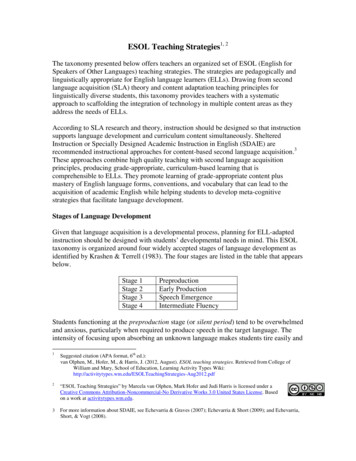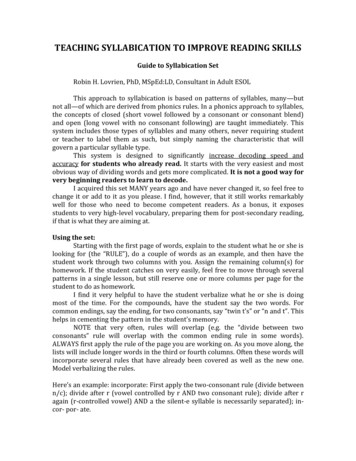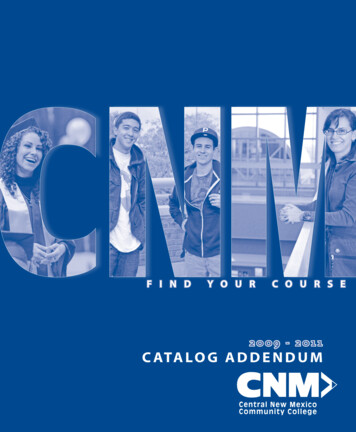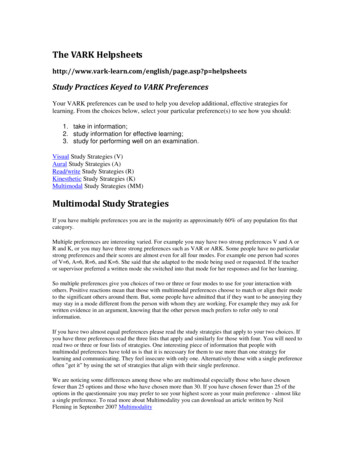
Transcription
ESOL Teaching Strategies1, 2The taxonomy presented below offers teachers an organized set of ESOL (English forSpeakers of Other Languages) teaching strategies. The strategies are pedagogically andlinguistically appropriate for English language learners (ELLs). Drawing from secondlanguage acquisition (SLA) theory and content adaptation teaching principles forlinguistically diverse students, this taxonomy provides teachers with a systematicapproach to scaffolding the integration of technology in multiple content areas as theyaddress the needs of ELLs.According to SLA research and theory, instruction should be designed so that instructionsupports language development and curriculum content simultaneously. ShelteredInstruction or Specially Designed Academic Instruction in English (SDAIE) arerecommended instructional approaches for content-based second language acquisition.3These approaches combine high quality teaching with second language acquisitionprinciples, producing grade-appropriate, curriculum-based learning that iscomprehensible to ELLs. They promote learning of grade-appropriate content plusmastery of English language forms, conventions, and vocabulary that can lead to theacquisition of academic English while helping students to develop meta-cognitivestrategies that facilitate language development.Stages of Language DevelopmentGiven that language acquisition is a developmental process, planning for ELL-adaptedinstruction should be designed with students’ developmental needs in mind. This ESOLtaxonomy is organized around four widely accepted stages of language development asidentified by Krashen & Terrell (1983). The four stages are listed in the table that appearsbelow.Stage 1Stage 2Stage 3Stage 4PreproductionEarly ProductionSpeech EmergenceIntermediate FluencyStudents functioning at the preproduction stage (or silent period) tend to be overwhelmedand anxious, particularly when required to produce speech in the target language. Theintensity of focusing upon absorbing an unknown language makes students tire easily and1Suggested citation (APA format, 6th ed.):van Olphen, M., Hofer, M., & Harris, J. (2012, August). ESOL teaching strategies. Retrieved from College ofWilliam and Mary, School of Education, Learning Activity Types egies-Aug2012.pdf2“ESOL Teaching Strategies” by Marcela van Olphen, Mark Hofer and Judi Harris is licensed under aCreative Commons Attribution-Noncommercial-No Derivative Works 3.0 United States License. Basedon a work at activitytypes.wm.edu.3For more information about SDAIE, see Echevarria & Graves (2007); Echevarria & Short (2009); and Echevarria,Short, & Vogt (2008).
shortens their attention spans. At this stage, students rely heavily upon nonverbalcommunication and whatever contextual clues they are able to perceive and understand.During the early production stage, students feel more comfortable with the targetlanguage, and can respond to questions with single words (e.g., “yes,” “no,” “you,”“me”). They are also able to recite short and simple texts (e.g. poems, short phrases,sentences). It is important to note that a low-anxiety learning environment fosters higherrisk-taking dispositions in ELLs. Therefore, it is critical that teachers create nurturinglearning environments by employing strategies such as circumlocution (offering multipleways to define a word or phrase), paraphrasing, and repetition.As students continue to develop their target language skills, they enter into the speechemergence stage. At this point, they begin providing longer answers to questions andmore complex utterances, and they use language more freely. With the use of longer andmore complex utterances, however, more syntax errors are produced. During this stage,teachers should scaffold instruction by providing many opportunities for students to workin small groups and to use organizers (advance and graphical) to help to generate ELLs’language. It is also helpful at this stage of development to permit students to use theirprimary language to support second language (L2) development (e.g., by memberchecking utterances with a bilingual peer or \teacher).Once students have reached the intermediate fluency stage, they are able to initiate andmaintain conversations in the target language. Syntax errors continue to be evident, but atthis stage, students are more aware of their language skills, and can often identify theirown errors and correct themselves. It is important to note that although ELLs may seemto know a good deal of English and may appear to be near-native in their conversationalEnglish at this stage, they have not achieved the same near-native proficiency inacademic English. To the less experienced educator, this can be a misleading stage, cangenerating unrealistic expectations for academic writing, advanced readingcomprehension, and/or oral presentation skills.Using the ESOL Strategies with Learning Activity TypesContent area teachers who are working with ELLs while seeking to incorporatecurriculum-based use of educational technologies should begin instructional planning ofeach lesson, project, and unit by selecting content goals and objectives. The next step isto identify the learning activity types best suited to students’ learning needs andpreferences with reference to those goals/objectives from appropriate content arealearning activity types taxonomy/ies. (Links to the most recent versions of all of theactivity types taxonomies are available at: http://activitytypes.wmwikis.net/.) Then,teachers need to identify their ELL students’ proficiency levels and choose the ESOLstrategies that best complement students’ learning that will be structured using theselected activity types.
The taxonomy presented below provides specific ESOL instructional strategies forteachers to use. These strategies are organized into eight general recommendations thatremind teachers to:a)b)c)d)e)f)g)h)Communicate clearly.Make content understandable.Check students’ understanding.Elicit students’ responses.Demonstrate and model.Encourage interpersonal communication.Group students to assist their learning.Promote cross-cultural awareness.Specific instructional strategies that can be used to operationalize each of theserecommendations appear in the sections and tables below.Once teachers select and sequence the learning activity types, then choose the ESOLstrategies to use within a specific lesson, project, or unit that they are planning, they canconsider the suggested technologies associated with each, selecting ones to use basedupon appropriateness, availability, and students’ and teachers’ prior experience. In thecharts of ESOL recommendations and strategies that appear below, the columns that read“Stage1,” “Stage 2,” “Stage 3,” and “Stage 4” correspond to the four stages of ELLstudents’ language development explained earlier: preproduction, early production,speech emergence, and intermediate fluency, respectively.Communicate ClearlyCommunicating clearly when working with language learners is very important. It iscommon for native speakers to think that they must speak slowly to be understood, andthat everyone understands idioms and other colloquial expressions given their wideusage. As native speakers, we are not fully aware of the wealth of linguistic knowledgeand resources we possess; we take this for granted. It is not until we are confronted withlearning another language that we become more conscious of how challenging it can beto do so. Communicating clearly requires using concrete language that is content-relatedand not idiomatic or colloquial. This section provides eight strategies for teachers to usethat will help them to communicate clearly when teaching language learners.
Table 1Strategies for Communicating ClearlyRecap and clarify primary points.XXAudio recorder to analyzeyour own speech patternsXXDocument camera, interactivewhiteboard, presentationsoftwareXXXXXXXXXXXVideo recorder (to analyzeyour use of body language)XXBulleted lists in presentationsand notesXXAudio recorder (to analyzeyour own speech patterns)XXPresentation software,document camera, interactivewhiteboard, word processor tocreate handoutsXXAudio recording software,audio discussion tools (e.g.VoiceThread)Document camera, interactivewhiteboard, presentationsoftwareSpeak more slowly (not moreloudly) with clear enunciation and Audio recorder (to analyzeexpression.your own speech patterns)Use body language to assistcomprehension.Use simple rather than complexsentence structures.Avoid including extraneousinformation when speaking.Explain instructions step-by-step.Stage 4Repeat and/or paraphrase withsufficient wait time.Clip-on microphone (forteacher)Possible TechnologiesStage 3Draw parallels between Englishand native language words andword parts (cognates).Stage 2Use concrete language/avoidcolloquialisms.Stage 1StrategyPosition ELLs in close proximityto the teacher.XXXXMake Content UnderstandableMaking content understandable or providing comprehensible input (Krashen, 1981) helpsteachers to communicate in an ESOL-friendly format that fosters students’ understanding
of the content being learned. While presenting information, teachers must make someadaptations that help students to understand key concepts. The table below shares 15strategies that teachers can use to improve ELLs’ comprehension of curriculum-basedcontent.Table 2Strategies for Making Content UnderstandableStrategyAnalyze curriculum goals andinstructional materials beforeusing them to identify potentialcomprehension difficulties.Possible TechnologiesStage 1Stage 2Stage 3Stage 4Word processor forannotations, scanner toannotate printed documentsXXXXProvide a synopsis/outline of thecontent to be explored.Presentation software,document camera, interactivewhiteboardXXXXPresentation software, videoclips, digital imagesXXXXPresentation software,document camera, wordprocessor to create printedimages to reference/display inclassXXXXProvide/construct graphicorganizers with words and/orpicturesConcept mapping software,word processorXXXXVisually emphasize (e.g., circle,highlight, display, label, animate)English words that represent keyconcepts.Presentation software,document camera, interactivewhiteboardXXXXXXXXXXXXXXActivate students’ backgroundknowledge, experiences,perceptions, and interests.Display visuals (e.g., images,diagrams, pictograms) thatillustrate content presented.List, define, and repeat new termsand concepts.Dramatize/mime/role play.Use real objects/manipulativesthat illustrate content presented.Presentation software,document camera, interactivewhiteboardVideo recorder to capturedramatization for futurereferenceVirtual manipulatives,physical manipulatives
Use native language, if possible,to explain confusing content.Provide alternative forms ofmaterials (e.g., text, video, audio,screen reader)Break complex ideas/texts intotheir component parts.Simplify and shorten longer texts(e.g., with bulleted lists).Provide tools and resources (e.g.,dictionary, thesaurus, etc.)Challenge students slightlybeyond their currentcomprehension levels.Language learning software orpodcasts to develop your ownvocabulary in students’ nativelanguage, translation softwareon a mobile device as areferenceXXPresentation software, videoclips, audio files, podcastsXXXXConcept mapping software,document cameraXXXXUse of bulleted lists inpresentation software, wordprocessed handouts and notesXXOnline dictionary/thesaurus,scanning pens, translatorsXXXXWeb sites, web-basedinteractive tools, mobiledevice appsXXXXCheck Students’ UnderstandingChecking for students’ understanding is part of most teaching procedures. With ELLs,frequent comprehension checks are key to both ongoing assessment and maintainingstudents’ engagement in the learning process. The table below suggests seven strategiesthat can be used to check students’ understanding.Table 3Strategies for Checking Students’ UnderstandingWord processor, Web-basedinteractive tools, interactivewhiteboard, concept mappingsoftwareStage 4Students complete sentences,charts, tables, etc.Stage 3Students think aloud.Stage 2Ask a question that the studentsanswer.Possible TechnologiesPresentation software,document camera, interactivewhiteboard to displayquestionsStage 1StrategyXXXXXXXXXXXX
Students restate an idea in theirown words.Students indicate a responsenonverbally (e.g., pointing, actingout, clicking)Word processor, audiorecorderXXStudent response system,printed student response cardsXXXXXXFocus on the meanings ofstudents’ statements more thantheir forms.Provide supportive feedback.Word processor, email,document cameraXXXXElicit Students’ ResponsesEliciting students’ responses helps teachers to perform periodic informal languageassessments. In response to teachers’ spoken and written prompts, ELLs producelanguage (output) that will vary in complexity, especially over time. Teachers can use theStudent Oral Language Observation (SOLOM) Matrix to estimate students’ spokenlanguage development and progress toward facility with academic English. The tablebelow offers eight strategies that help to elicit students’ responses.Table 4Strategies for Eliciting Students’ ResponsesStage 2Stage 3Stage 4Possible TechnologiesPresentation software,Ask questions that evoke simpledocument camera, interactiveresponses (e.g., words or phrases).whiteboard to displayquestionsAsk students what would beWeb-based survey, email,helpful to their learning.student response systemPrompt student responses ofincreased complexity over time.Solicit students’ perspectives,Web-based survey, email,experiences, etc.blogs, discussion forum,student response systemRequest written responses indifferent formats (e.g, answers to Word processor, drawingquestions, poetry, news stories,software, animation software,picturebooks, letters, skits)video/audio creation softwareStage 1StrategyXXXXXXXXXXXXXXXXXX
Provide structures for writtenresponses (e.g., templates,questions)Word processor, conceptmapping softwareXXXAsk students toidentify/summarize keyconcepts/main ideasWord processor, conceptmapping softwareXXXXPresentation software,audio/video creation software,audio/video recorderXXXXAsk students to do oralpresentations, reports, skits, etc.Demonstrate/ModelModeling and demonstration are generally effective instructional approaches. Whenteaching ESOL students, it is helpful for teachers to demonstrate—in advance and stepby-step—what is expected from students, and to model ways of thinking, behaving andcommunicating that will help students to reach curriculum-based learning goals. Thestrategies presented below can assist all learners—monolinguals and ELLs. The chartoffers seven strategies that can support teachers’ modeling and demonstrations.Table 5Strategies for Demonstrating/ModelingStage 2Stage 3XXXBooks, Web-based readingsXXXXXXXXXXXXXXXXXXXXXXXXPossible TechnologiesModel decoding skills and wordanalysis.Presentation software,document camera, interactivewhiteboardPresentation software,document camera, interactivewhiteboardPresentation software,document camera, interactivewhiteboardPresentation software,document camera, interactivewhiteboardPresentation software, videorecorderModel comprehension strategies.Model language learningstrategies.Model study skills.Model presentation skills.Stage 4Stage 1Audio recorderStrategyUse mnemonics to build memoryof content.Use read-alouds and/or readalongs.
Encourage Interpersonal CommunicationAll learners need to interact with peers, teachers, and others involved in the learningprocess, regardless of their language backgrounds. For ELLs, it is even more important tohave extensive opportunities to practice oral and written communicative language. Byinteracting with peers, teachers, and others, ELLs can expand their content knowledge aswell as strengthen their second-language reading and writing skills. The chart belowsuggests eight strategies that encourage interpersonal communication within and beyondthe classroom.Table 6Strategies to Encourage Interpersonal CommunicationStrategyProvide tutoring/mentoring(peers, teachers, communitymembers)Possible TechnologiesStage 1Stage 2Stage 3Stage 4Web-based discussion, email,chat, videoconferencingXXXXSet up conversation partnersWeb-based discussion, email,chat, videoconferencingXXXXAudio recorder to review laterXXWeb-based discussion, email,chat, videoconferencingXXStudents summarize each other’spoints in a conversation.Exchange opinions, emotions,and/or perspectives.Presentation software, conceptmapping software, Web-baseddiscussion, email, chatXXXXChat, Web-based discussionXXXXExchange written documents(e.g., letters, stories, dialoguejournals, peer feedback, etc.).Word processor, wiki, email,blogXXXXExtend opportunities forinterpersonal communicationbeyond the classroom.Web-based discussion, email,chat, blog, videoconferencingXXXXShare information.Ask and answer questions.
Group Students to Assist Their LearningGrouping students strategically can assist their learning in multiple ways. Teachers oftentry to keep ELLs away from other students with similar linguistic backgrounds to preventthem from talking with each other in their native language. At times, it can be helpful forstudents to work with a group member who speaks their native language to prevent theELL from getting lost. However, it is not a good idea to segregate ELLs by nativelanguage. Groupings—in same-language or different-language clusters—should bedetermined by considering the nature of the learning task at hand and the languagefacility of the students participating. The following table offers five strategies thatteachers can use when grouping their ELL students.Table 7Strategies for Grouping Students to Assist Their LearningXXXWork with partners at similarEnglish language proficiencylevels initially.Keep group sizes small andincrease numbers gradually.Work collaboratively to create aproduct.Work cooperatively toaccomplish a task.Stage 4Stage 3Videoconferencing, wiki,blogsStage 2Possible TechnologiesStage 1StrategyWork with a partner who canspeak in the student’s nativelanguage.XXXXXXWiki, collaborative wordprocessorXXXXWiki, collaborative wordprocessorXXXXPromote Cross-Cultural AwarenessELLs arrive with diverse cultural backgrounds. Helping ELLs to develop anunderstanding and appreciation of their adopted country’s culture should not be pursuedat the expense of fostering respect for and maintenance of students’ cultural identities.The table below provides seven strategies that can support such intercultural endeavorswith ELLs.
Table 8Strategies for Promoting Cross-Cultural AwarenessStage 1Stage 2Stage 3Stage 4StrategyShow respect and appreciation forELL’s native language bylearning (and teaching to theclass) basic greetings or keywords in the target language.Present to the class differentholidays from ELLs’ homecountries and from the U.S.Invite guest speakers (face-to-faceor virtual visits).Take classroom virtual tours toELL’s home country’s iconicplaces and compare those ofsimilar meaning for U.S. people.Extend opportunities to conductethnographic interviews amongstudents from differentbackgrounds.Pair ELLs with Americanstudents to compare and contrasteveryday patterns of life aspertains to students’ age.Activate students’ previousexperiences from home countriesand have them write XXXWeb-based virtual tours,DVDs, video streaming sites,videoconferencingXXXXAudio/Video recorders, wordprocessor, presentationsoftware, videoconferencingXXXXConcept mapping softwareXXXXXXXPossible TechnologiesTranslators, Web-baseddictionariesVideo streaming sites, DVDsWord processor, blogConclusionMany of the strategies shared here will be familiar to experienced teachers, but theirhelpfulness to ELLs is not often considered. When second language acquisitionprinciples are used for curriculum-based teaching, they can contribute to better learningfor both ELL and non-ELL students. We hope that the taxonomy of ESOL teachingstrategies presented here, used in conjunction with taxonomies of curriculum-basedlearning activity types, will assist teachers with planning, organizing, and offeringinstruction that is appropriately supported with digital and non-digital tools andresources.
AcknowledgementsWe offer thanks to Dr. Paul García (at Kansas University) and Drs. Jeffra Flaitz and JaneGovoni (at Saint Leo University) for their insightful comments and suggestions forrevisions to earlier versions of this manuscript.ReferencesEchevarria, J. & Graves, A. (2007). Sheltered content instruction: Teaching Englishlanguage learners with diverse abilities (3rd ed.). Boston: Allyn & Bacon.Echevarria, J. & Short, D. (2009). Programs and practices for effective sheltered contentinstruction. In D. Dolson & L. Burnham-Massey (Eds.), Improving education forEnglish learners: Research-based approaches (pp. 250-321). Sacramento, CA:California Department of Education Press.Echevarria, J., Short, D., & Vogt, M.E. (2008). Implementing the SIOP model througheffective professional development and coaching. Boston: Pearson/Allyn &Bacon.Krashen, S. (1981). Principles and practice in second language acquisition (EnglishLanguage Teaching Series). London: Prentice-Hall International.Krashen, S. & Terrell, T. (1983). The natural approach: Language acquisition in theclassroom. San Francisco: The Alemany Press.
recommended instructional approaches for content-based second language acquisition. 3. These approaches combine high quality teaching with second language acquisition principles, producing grade-appropriate, curriculum-based learning that is comprehensible to ELLs. They promote learning










